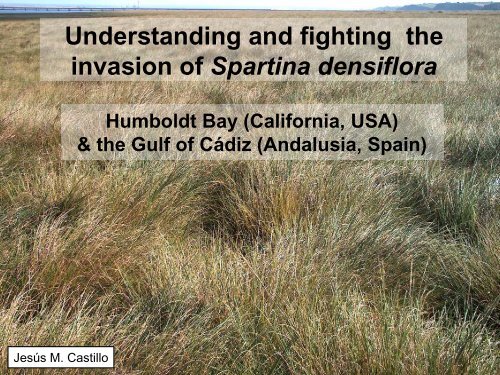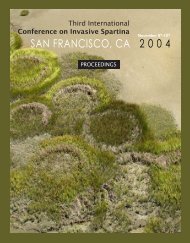S. densiflora - San Francisco Estuary Invasive Spartina Project
S. densiflora - San Francisco Estuary Invasive Spartina Project
S. densiflora - San Francisco Estuary Invasive Spartina Project
Create successful ePaper yourself
Turn your PDF publications into a flip-book with our unique Google optimized e-Paper software.
Understanding and fighting the<br />
invasion of <strong>Spartina</strong> <strong>densiflora</strong><br />
Humboldt Bay (California, USA)<br />
& the Gulf of Cádiz (Andalusia, Spain)<br />
Jesús M. Castillo
The main threat to the conservation of salt marshes in the Gulf of Cadiz is<br />
the invasion of the South American neophyte <strong>Spartina</strong> <strong>densiflora</strong>, which<br />
was introduced to this coast around the16-17th centuries.<br />
Gulf of Cadiz (SW Iberian Peninsula)
This conservation problem is shared by salt marshes in Northern California,<br />
including Humboldt Bay and Mad River wetlands, and Corte Madera Marsh at <strong>San</strong><br />
<strong>Francisco</strong> Bay, where S. <strong>densiflora</strong> was introduced during 19th century.<br />
Humbolt Bay and mad river (Noth California)
‘SEA OF SPARTINA’ AT HUMBOLDT BAY<br />
The final outcome of the S. <strong>densiflora</strong> invasion is almost monospecific<br />
communities where the alien species colonise most of the available space.
S. <strong>densiflora</strong> has already occupied close to 100 % of the space at some marshes in<br />
both geographic regions. However, it is still spreading out in many other marshes,<br />
and many others have not been yet been colonised by the alien species.<br />
Distribution of S.<br />
<strong>densiflora</strong> in the salt<br />
marshes of Guadiana<br />
River (SW Spain)<br />
Spread of S.<br />
<strong>densiflora</strong><br />
invasion
Then, we are still in time to control the<br />
invasion and to eradicate S. <strong>densiflora</strong> in<br />
many locations…<br />
… but we must act as soon as possible<br />
so our objectives will be easier to<br />
achieve, since S. <strong>densiflora</strong> shows a very<br />
high capacity to disperse by seeds.<br />
If we do not do anything we will lose the<br />
biodiversity, the landscapes and other<br />
environmental resources and functions of<br />
our salt marshes.
S. <strong>densiflora</strong> starting its invasion of a salt marsh at Humboldt Bay
Themostimpactedtaxaby theinvasionofS. <strong>densiflora</strong> are rare taxa growing at<br />
middle (at SW Iberian Peninsula) and high marshes (at Humboldt Bay, California).<br />
Ej.<br />
SW Iberian Peninsula<br />
Artemisia caerulescens subsp. caerulescens L.<br />
Aster tripolium subsp. panonnicus (Jacq.) Soó<br />
Triglochin barrelieri Loisel.<br />
Limonium algarvense Erben<br />
Etc.<br />
Northern California<br />
Carex lyngbyei<br />
Cirsium loncholepis<br />
Cordylanthus maritimus ssp. Palustris<br />
Puccinellia pumila<br />
Limonium sp.<br />
Etc.<br />
Middle marsh at Piedras River <strong>Estuary</strong><br />
(Andalusia)
S. <strong>densiflora</strong> is able to colonise many different habitats because:<br />
It tolerates very wide ranges of many abiotic environmental conditions such as<br />
salinity and flooding;<br />
and it is a very competitive species due to its ‘phalanx’ growth form.<br />
Image from Terrestrial Vegetation of California. 3rd edition. Chapter 5.
<strong>Spartina</strong> <strong>densiflora</strong> colonising a high marsh with high salinities during summer
S. <strong>densiflora</strong> at river mouths<br />
Mad River<br />
(California)<br />
Guadalquivir River<br />
(Andalusia)
S. <strong>densiflora</strong> at tidal channel banks<br />
Humboldt Bay<br />
(California)<br />
Piedras River<br />
(Andalusia)
S. <strong>densiflora</strong> at brackish marshes<br />
Humboldt Bay<br />
(California)<br />
Nicoba River<br />
(Andalusia)
S. <strong>densiflora</strong> at intertidal plains<br />
Humboldt Bay<br />
(California)<br />
Odiel marshes<br />
(Andalusia)
S. <strong>densiflora</strong> at sandy deposits<br />
Humboldt Bay<br />
(California)<br />
Odiel marshes<br />
(Andalusia)
The phenotypical plasticity of S. <strong>densiflora</strong> is reflected even in the duration of its life<br />
cycle. In the Odiel marshes (SW Iberian Península), it behaves as a biennial at its<br />
lower distribution limit in the tidal frame and as a perennial at higher elevations.<br />
Biennial population of S. <strong>densiflora</strong> at a low<br />
marsh in the Odiel marshes
But S. <strong>densiflora</strong> is not able to colonise lower elevations in the tidal frame<br />
and areas with very high salinities or exposed to temporal drought (salt<br />
ponds and high marshes at SW Iberian Peninsula).<br />
Arthrocnemum machrostachyum growing on a salt-pan during summer at the Odiel marshes
Perennial population<br />
Biennial population<br />
Lower distribution limit of <strong>Spartina</strong> <strong>densiflora</strong><br />
<strong>Spartina</strong> maritima
On the other hand, S. <strong>densiflora</strong> may form hybrids with native cordgrasses as<br />
described in <strong>San</strong> <strong>Francisco</strong> Bay between S. <strong>densiflora</strong> and S. foliosa and in the<br />
Odiel marshes with S. maritima.<br />
S. <strong>densiflora</strong> and S. maritima growing together<br />
at the Odiel marshes.
Humboldt Bay<br />
(California)<br />
S. <strong>densiflora</strong> slows down its<br />
production during winter when it<br />
finds dormant perennials in<br />
Northern California and nondormant<br />
perennials in Andalusia.<br />
Odiel marshes<br />
(Andalusia)
A few salt marsh restoration projects based on fighting S. <strong>densiflora</strong><br />
invasion are being developed at Andalusia and California…<br />
Salt marsh at Humboldt Bay recovering after mowing of S. <strong>densiflora</strong>
Removing S. <strong>densiflora</strong> at <strong>San</strong> <strong>Francisco</strong> Bay (California)
Removing S. <strong>densiflora</strong> at the Odiel marshes (SW Spain)







